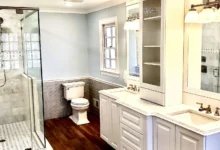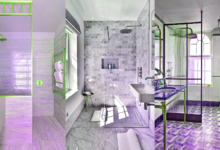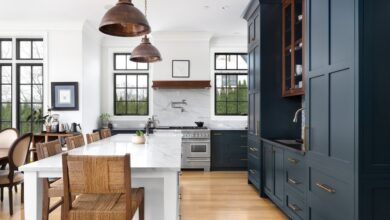Bathroom Remodel Guide Designs That Add Value
Bathroom Remodel Guide Designs That Add Value
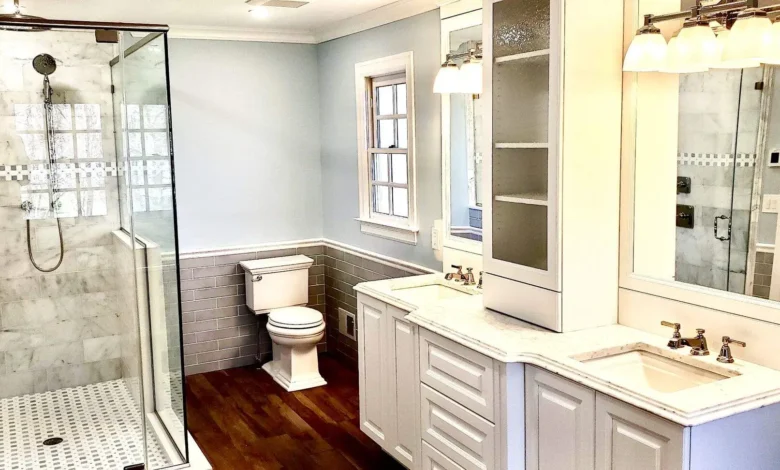
Planning a bathroom remodel can feel overwhelming, but the right design choices can significantly increase your home’s value while creating a luxurious personal retreat. Whether you’re considering a minor refresh or a complete renovation, understanding which design elements deliver the highest return on investment (ROI) is crucial for homeowners looking to maximize both functionality and resale value.
A well-executed bathroom renovation offers one of the best returns among home improvement projects. According to recent Cost vs. Value reports, midrange bathroom remodels recoup approximately 73-74% of their investment at resale, making them a smart financial decision for homeowners. The key lies in selecting timeless designs, quality materials, and strategic upgrades that appeal to today’s buyers while enhancing your daily living experience.
Modern bathroom design trends in 2024-2025 emphasize sustainability, smart technology integration, and spa-like features that transform ordinary bathrooms into personal sanctuaries. From walk-in showers with luxurious tile work to energy-efficient fixtures and smart storage solutions, today’s bathroom renovations blend style with substance. Understanding which upgrades add the most value—and which to avoid—can help you make informed decisions that benefit both your lifestyle and your home’s market appeal.
This comprehensive guide explores proven strategies for creating value-adding bathroom designs, covering everything from budget-friendly updates to luxury renovations. We’ll examine the latest trends, discuss cost-effective materials, and provide actionable insights to help you navigate your bathroom transformation journey. Whether you’re planning to sell soon or simply want to enhance your home’s comfort and functionality, these expert recommendations will guide you toward design choices that deliver lasting value and satisfaction.
Understanding Bathroom Remodel Guide
The Financial Impact of Bathroom Renovations
Bathroom remodeling consistently ranks among the top home improvements for return on investment. Recent market data shows that homeowners can expect to recoup 60-85% of their renovation costs, depending on the scope and quality of the project. A midrange bathroom remodel recoups approximately 73.7% of its cost upon resale, while minor budget remodels can recoup 70-85% of costs.
The variation in ROI depends on several factors:
Project Scope and Investment Level: Minor remodels focusing on cosmetic updates typically offer higher percentage returns than major renovations involving structural changes. A $15,000 midrange renovation often provides better ROI than a $65,000 luxury overhaul, though both add significant value.
Market Conditions: Local real estate markets heavily influence renovation returns. In competitive markets with high home values, bathroom upgrades can push properties into higher price brackets, maximizing the investment return.
Quality vs. Cost Balance: Premium materials, modern fixtures, heated floors, and professional craftsmanship can significantly boost the home’s market value, but over-improving for your neighborhood can limit returns.
Strategic Value-Adding Elements
The most successful bathroom renovations focus on updates that modern buyers expect:
Updated Plumbing Fixtures: Replacing outdated faucets, showerheads, and toilets with water-efficient models appeals to environmentally conscious buyers while reducing utility costs.
Improved Lighting and Ventilation: Proper lighting design and adequate ventilation prevent moisture issues while creating an inviting atmosphere that showcases the space effectively.
Accessible Design Features: Universal design elements like grab bars, wider doorways, and curbless showers increase the home’s appeal to a broader range of potential buyers.
Popular Bathroom Design Trends That Add Value
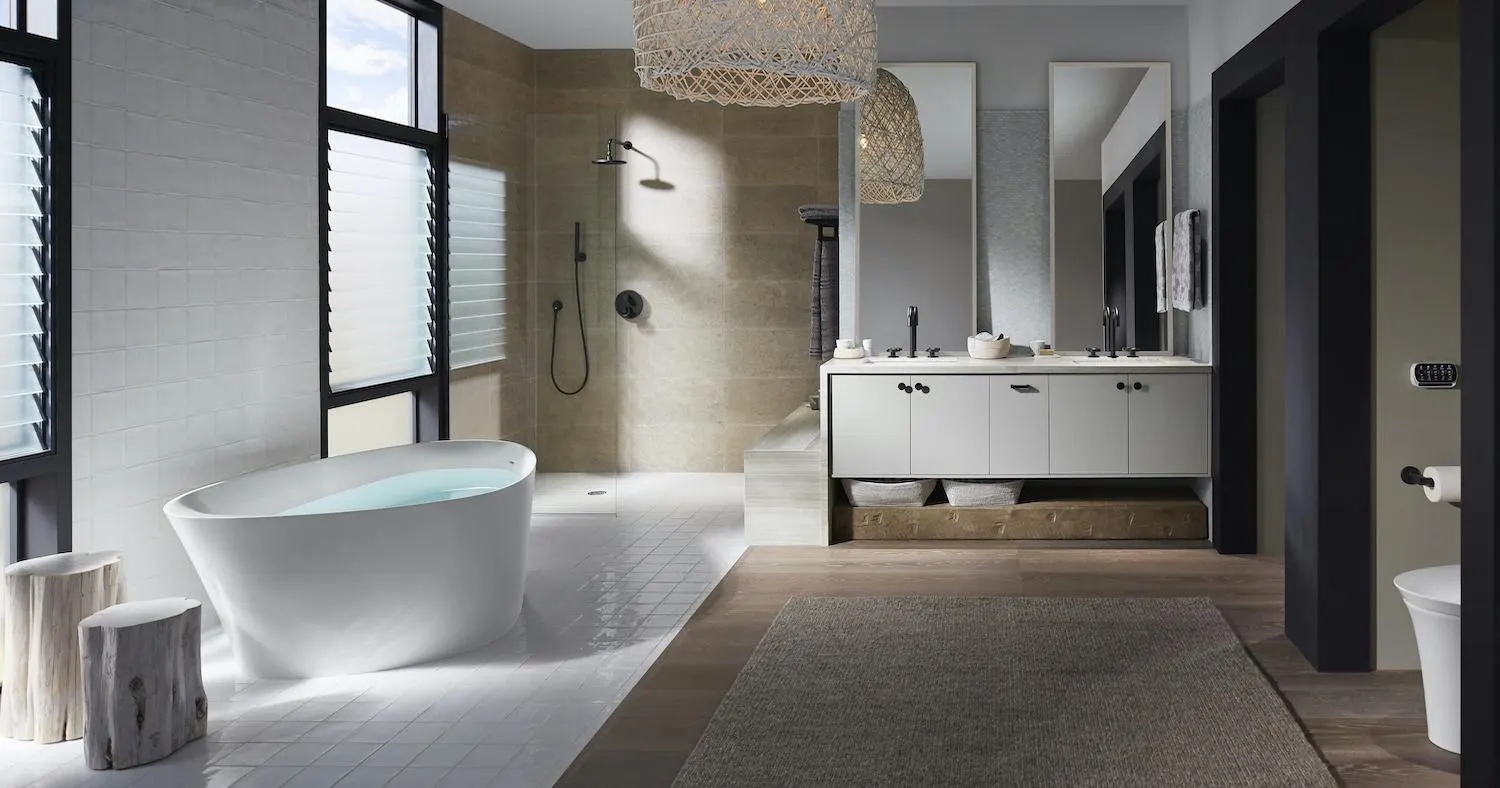
Timeless vs. Trendy Design Choices
Choosing neutral, timeless designs is one of the most effective ways to maximize ROI in a bathroom renovation. Colors like white, beige, gray, and soft pastels appeal to a broad range of buyers and create a clean, open look. While bold trends can create stunning focal points, classic design elements ensure broader market appeal.
Neutral Color Palettes: Whites, grays, and earth tones provide versatile backdrops that buyers can easily personalize. These colors also make spaces appear larger and brighter, key selling points in bathroom design.
Classic Tile Patterns: Subway tiles, hexagonal patterns, and natural stone finishes remain popular because they transcend fleeting trends. These choices offer longevity and broad appeal while allowing personality through accent pieces.
Traditional Fixtures with Modern Functionality: Combining classic styling with contemporary features like touchless faucets or LED lighting creates the perfect blend of timeless appeal and modern convenience.
2024-2025 Design Trends Worth Investing In
Current bathroom design trends focus on sustainability, technology integration, and wellness-focused features:
Spa-Inspired Elements: The trends for 2024 highlight the importance of sustainability, luxury, and smart technology in bathroom designs. Steam showers, heated floors, and freestanding soaking tubs transform bathrooms into personal wellness retreats.
Smart Technology Integration: Digital shower controls, smart mirrors with integrated lighting, and voice-activated fixtures appeal to tech-savvy buyers while improving daily functionality.
Sustainable Materials: Eco-friendly options like recycled glass tiles, bamboo vanities, and low-VOC finishes attract environmentally conscious buyers and often qualify for green building certifications.
Mixed Metal Finishes: Combining different metal tones adds visual interest and sophistication. Popular combinations include matte black with brass accents or brushed nickel with copper details.
Essential Design Elements for Maximum Value
Functional Layout Optimization
Bathroom layout design significantly impacts both usability and resale value. Efficient space planning maximizes functionality while creating visual appeal:
Strategic Storage Solutions: Built-in niches, floating vanities, and tall cabinets maximize storage without cluttering the visual space. Hidden storage keeps essentials organized while maintaining clean lines.
Optimal Traffic Flow: Ensuring adequate clearances around fixtures improves daily usability and meets building codes. Standard clearances include 30 inches in front of toilets and 36 inches for shower entries.
Universal Design Principles: Incorporating accessible features doesn’t compromise style while making spaces usable for all ages and abilities. Comfort-height toilets, lever-style handles, and barrier-free showers increase market appeal.
High-Impact Fixture Upgrades
Modern bathroom fixtures serve as focal points while providing essential functionality:
Statement Vanities: Double vanities in master bathrooms remain highly desired, offering personal space for couples. Floating designs create visual spaciousness, while traditional styles with ample storage appeal to families.
Luxurious Shower Systems: Walk-in showers with multiple spray options, built-in seating, and premium tile work create spa-like experiences. Frameless glass enclosures enhance the sense of space and showcase beautiful tilework.
Efficient Toilets: High-efficiency models reduce water consumption while offering improved performance. Wall-mounted options save floor space and create contemporary aesthetics, though traditional floor-mounted models remain broadly popular.
Lighting and Ventilation Excellence
Proper lighting design transforms bathroom ambiance while ensuring functionality:
Layered Lighting Approach: Combining ambient, task, and accent lighting creates versatile environments suitable for different activities. Recessed ceiling lights provide general illumination, while vanity lighting ensures proper task visibility.
Natural Light Maximization: Skylights, larger windows, or solar tubes bring natural light into interior spaces. Privacy glass or strategic window placement maintains comfort while brightening the environment.
Advanced Ventilation Systems: Quiet, efficient exhaust fans prevent moisture damage while maintaining air quality. Timer and humidity sensor controls ensure automatic operation without manual intervention.
Material Selection for Long-Term Value
Flooring Options That Endure
Bathroom flooring must withstand moisture, temperature changes, and heavy use while maintaining aesthetic appeal:
Porcelain and Ceramic Tiles: These materials offer excellent water resistance, durability, and design versatility. Large-format tiles minimize grout lines, creating cleaner appearances and easier maintenance.
Luxury Vinyl Plank (LVP): Modern LVP provides wood-like aesthetics with superior water resistance and comfort underfoot. Quality products include lifetime warranties and realistic textures that rival natural materials.
Natural Stone: Marble, travertine, and slate create luxurious foundations but require proper sealing and maintenance. These premium materials significantly increase perceived value in upscale markets.
Wall Treatments and Tile Selection
Wall materials balance aesthetics, functionality, and maintenance requirements:
Subway Tiles: Classic 3×6 subway tiles remain popular for their versatility and timeless appeal. Modern variations include larger formats, colored glazes, and textured surfaces that add visual interest.
Large Format Tiles: Oversized tiles create seamless appearances with minimal grout lines. They work particularly well in smaller spaces, creating illusions of greater size and continuity.
Natural Stone Accents: Strategic use of marble, travertine, or slate as accent walls or shower surrounds adds luxury without overwhelming budgets. These materials work best when balanced with more affordable complementary options.
Countertop and Vanity Materials
Bathroom vanities and countertops significantly impact both functionality and aesthetics:
Quartz Countertops: Engineered quartz offers consistent patterns, non-porous surfaces, and excellent durability. It requires no sealing and provides stain resistance superior to natural stone.
Solid Wood Vanities: Quality hardwood vanities with proper finishes create warmth and character. Popular species include oak, maple, and walnut, chosen for their durability and grain patterns.
Cultured Marble: This affordable option provides seamless integration of countertops and backsplashes. Modern formulations offer improved durability and more realistic natural stone appearances.
Budget-Friendly Updates with High Impact
Cosmetic Improvements That Transform
Not all valuable bathroom upgrades require major investments. Strategic cosmetic improvements deliver significant visual impact:
Paint and Hardware Updates: Fresh paint in neutral colors instantly modernizes any space. Updating cabinet hardware, towel bars, and light fixtures creates cohesive styling without major expense.
Mirror and Lighting Enhancements: Large mirrors visually expand spaces while improved lighting showcases other upgrades. LED vanity lighting provides better task illumination and energy efficiency.
Faucet and Showerhead Replacements: Modern fixtures with water-saving features appeal to efficiency-conscious buyers. Brushed nickel, matte black, and brass finishes coordinate with current design trends.
Strategic Partial Renovations
Focused improvements allow homeowners to maximize impact within limited budgets:
Vanity Area Redesign: Updating the vanity, mirror, and lighting creates a fresh focal point without touching plumbing. This approach works particularly well in powder rooms and half baths.
Shower Refresh: New tile surrounds, updated fixtures, and improved glass enclosures transform shower areas without full renovations. This strategy works when existing layouts remain functional.
Storage and Organization: Adding built-in shelving, medicine cabinets, and vanity organizers improves functionality while reducing clutter. These improvements enhance daily usability and buyer appeal.
Planning Your Bathroom Renovation Project
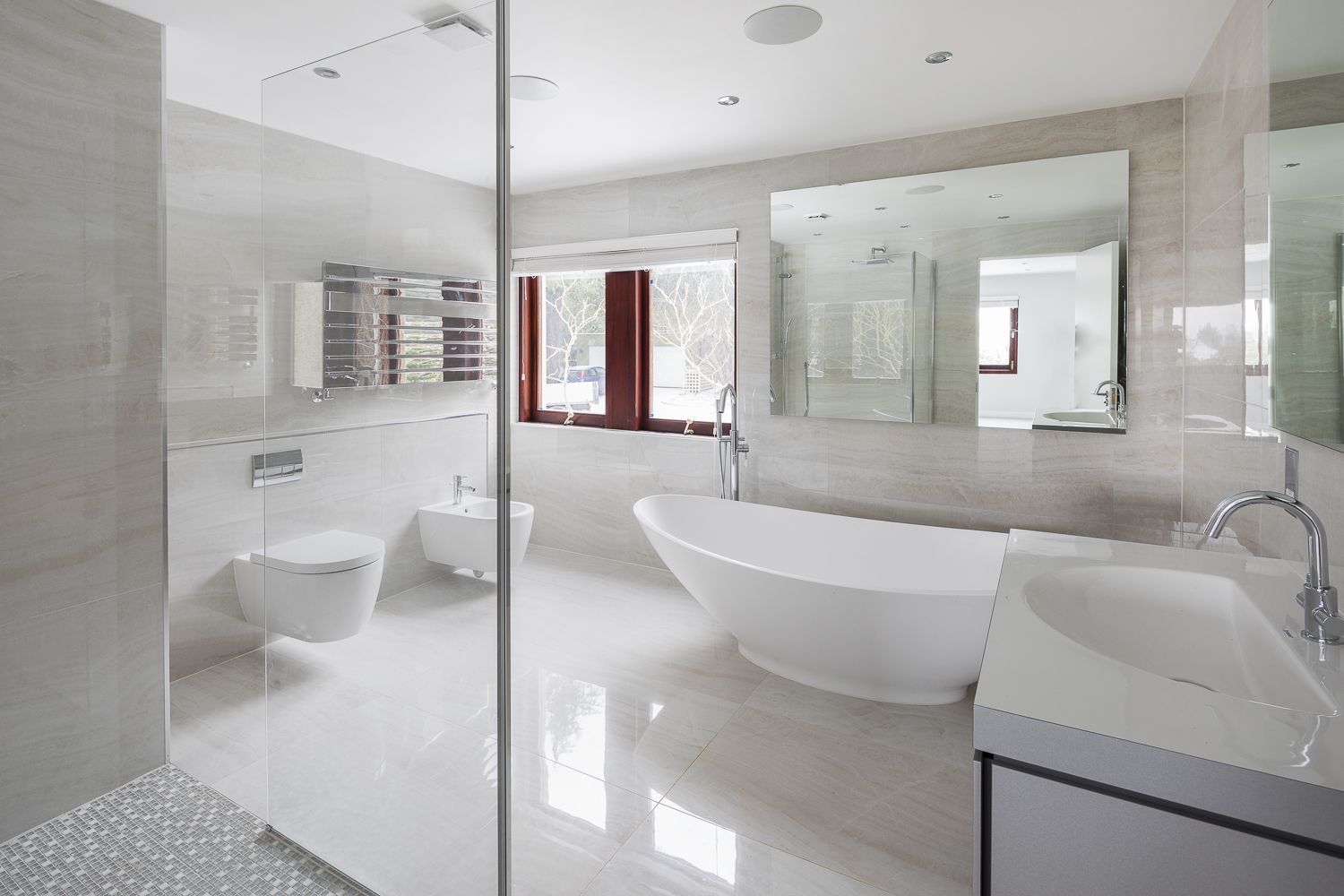
Establishing Realistic Budgets
Successful bathroom remodeling projects begin with realistic budget planning based on scope and desired outcomes:
Minor Refresh ($5,000-$15,000): Cosmetic updates including paint, fixtures, vanity, and flooring replacement. These projects typically require 1-2 weeks and offer excellent ROI potential.
Moderate Renovation ($15,000-$35,000): Expanded scope including layout modifications, electrical updates, and premium fixtures. Timeline extends to 3-4 weeks with professional coordination required.
Luxury Transformation ($35,000+): Complete renovations with structural changes, high-end materials, and custom features. These projects require 6-8 weeks and professional project management for optimal results.
Timeline and Project Management
Understanding renovation phases helps homeowners plan effectively:
Design and Planning Phase: Spend adequate time on design development, permit acquisition, and material selection. Rushing this phase often leads to costly changes during construction.
Construction Sequencing: Proper sequencing prevents delays and rework. Typical order includes demolition, rough plumbing/electrical, insulation, drywall, flooring, fixtures, and final details.
Contingency Planning: Reserve 15-20% of the budget for unexpected issues like hidden water damage or outdated electrical systems. Older homes often require additional structural or systems updates.
Hiring Professional Help vs. DIY Approaches
Determining when professional help is essential ensures quality results and code compliance:
Professional Requirements: Plumbing relocations, electrical work, and structural modifications typically require licensed professionals. Many jurisdictions mandate permits and inspections for safety compliance.
DIY-Friendly Tasks: Painting, installing fixtures, tile work, and cabinet installation can be homeowner projects with proper research and tools. These tasks offer opportunities for budget savings.
Hybrid Approaches: Many homeowners successfully combine professional rough work with DIY finishing tasks. This strategy balances quality assurance with cost control while maintaining project timelines.
Common Mistakes to Avoid
Design Pitfalls That Reduce Value
Understanding common bathroom renovation mistakes helps homeowners make better decisions:
Over-Personalizing Design Choices: Extremely bold colors, unusual fixtures, or highly personalized themes may reduce broad market appeal. Save dramatic design elements for easily changeable accessories.
Inadequate Storage Planning: Failing to provide sufficient storage reduces functionality and buyer appeal. Plan for toiletries, linens, cleaning supplies, and personal items from the design phase.
Poor Ventilation Decisions: Inadequate ventilation leads to moisture problems, mold growth, and material damage. Invest in proper exhaust systems sized appropriately for space volume.
Budget and Planning Errors
Financial and logistical mistakes can derail otherwise successful projects:
Unrealistic Budget Expectations: Underestimating costs leads to compromised material choices or incomplete projects. Research costs thoroughly and include appropriate contingencies.
Ignoring Building Codes: Code violations can halt projects, require expensive corrections, or affect home sales. Verify requirements before beginning work and obtain necessary permits.
Poor Timing Decisions: Renovating during peak construction seasons increases costs and extends timelines. Plan projects during off-peak periods when contractor availability improves.
Working with Professionals
Selecting Qualified Contractors
Choosing the right bathroom remodeling contractor significantly impacts project success:
Verification and References: Check licenses, insurance coverage, and Better Business Bureau ratings. Contact recent clients to discuss work quality, timeline adherence, and problem resolution.
Detailed Proposals: Quality contractors provide comprehensive proposals including materials specifications, timeline details, and change order procedures. Avoid unusually low bids that may indicate corner-cutting.
Communication Standards: Establish clear communication expectations, including progress updates, decision points, and problem escalation procedures. Good contractors maintain regular contact throughout projects.
Design Professional Benefits
Interior designers and design-build firms offer valuable expertise:
Space Planning Optimization: Professional designers maximize functionality within existing constraints while creating aesthetically pleasing environments. Their experience prevents costly layout mistakes.
Material and Finish Coordination: Design professionals help coordinate colors, textures, and finishes for cohesive results. They often have access to trade-only products and preferred pricing.
Project Coordination: Design-build firms manage entire projects from concept through completion, streamlining communication and responsibility while maintaining quality standards.
Maintenance and Long-Term Care
Protecting Your Investment
Proper maintenance preserves bathroom renovation value while extending material lifecycles:
Regular Cleaning Protocols: Establish appropriate cleaning routines for different materials. Natural stone requires different care than ceramic tiles, while custom finishes may have specific requirements.
Preventive Maintenance: Regular caulk inspection, grout cleaning, and ventilation system maintenance prevent minor issues from becoming major problems. Schedule annual professional inspections for complex systems.
Warranty Management: Maintain documentation for all materials and workmanship warranties. Address issues promptly to maintain coverage and prevent escalation into larger problems.
Seasonal Considerations
Climate-related maintenance protects materials and systems:
Humidity Control: Monitor and control humidity levels to prevent mold growth and material damage. Adjust ventilation usage seasonally based on exterior conditions.
Temperature Management: Prevent pipe freezing in unheated areas during the winter months. Maintain consistent temperatures to prevent material expansion and contraction damage.
Seasonal Deep Cleaning: Schedule thorough cleaning and maintenance during spring and fall transitions. This timing allows identification and correction of issues before extreme weather seasons.
Future-Proofing Your Bathroom Design
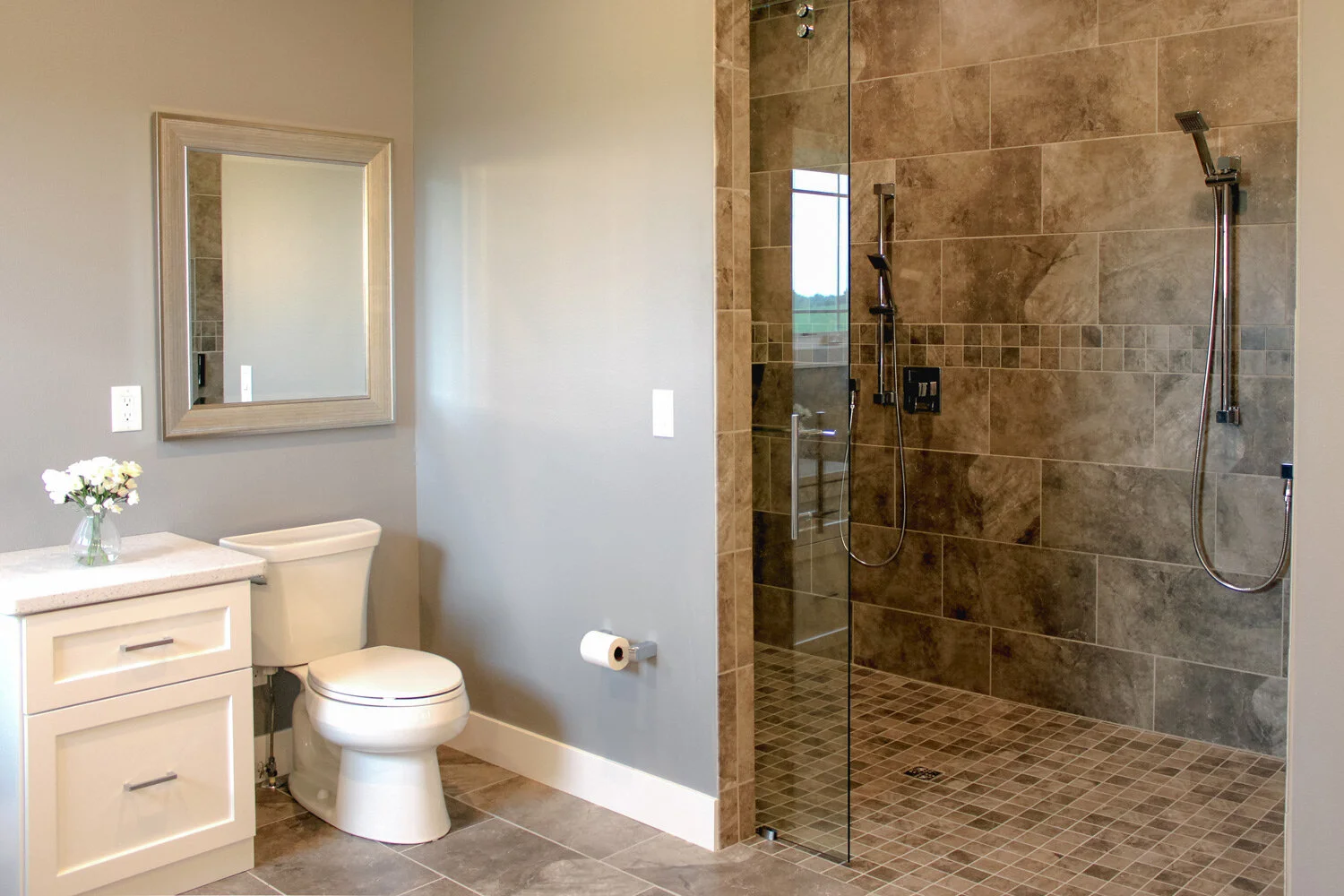
Aging-in-Place Considerations
Smart design choices accommodate changing needs over time:
Universal Design Integration: Incorporate accessible features during initial renovation rather than retrofitting later. Comfort-height toilets, lever handles, and barrier-free showers benefit users of all ages.
Structural Preparation: Install blocking for future grab bar installation, even if not immediately needed. This preparation costs minimal upfront while avoiding major modifications later.
Flexible Layout Planning: Design layouts that accommodate mobility aids or equipment if needed. Wider doorways, open floor areas, and accessible storage enhance long-term usability.
Technology Integration Opportunities
Smart Home Integration: Plan infrastructure for future smart home systems, including adequate electrical capacity, wi-fi coverage, and device mounting locations. These preparations position homes for evolving technology.
Energy Efficiency Upgrades: Specify energy-efficient fixtures, LED lighting, and high-performance ventilation systems. These choices reduce operating costs while appealing to environmentally conscious buyers.
Water Conservation Features: Install water-saving fixtures and consider greywater systems where regulations permit. These features reduce utility costs while supporting sustainability goals.
More Read: How to Remodel Your Bathroom on a Budget
Conclusion
A well-planned bathroom remodel represents one of the smartest home improvement investments, offering substantial returns while enhancing daily living experiences. By focusing on timeless design elements, quality materials, and strategic upgrades that appeal to broad market segments, homeowners can create beautiful, functional spaces that deliver lasting value.
The key to success lies in balancing personal preferences with market realities, investing in professional expertise when needed, and maintaining realistic budgets that allow for quality execution. Whether pursuing minor updates or complete transformations, thoughtful planning and attention to proven value-adding elements ensure renovation projects deliver both immediate satisfaction and long-term financial benefits.
